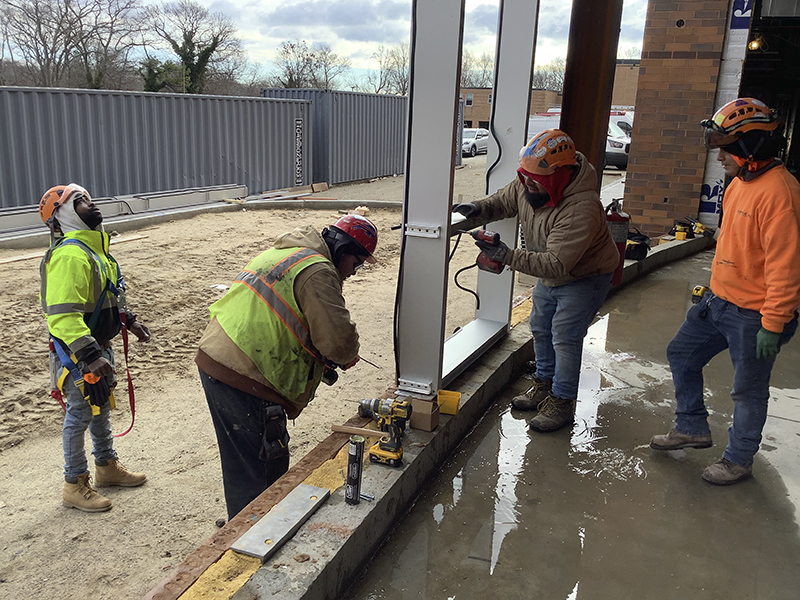
Working in cold weather during the winter months can be just as dangerous as working in extreme heat during the warmer days of the year. Preventing frostbite, hypothermia, cold stress, driving safely on icy roads, and being careful on slippery sidewalks are all part of the job during the winter.
PREVENTING AND TREATING WINTER WEATHER ILLNESS
According to the Occupational Safety and Health Administration (OSHA), winter weather presents hazards including slippery roads/surfaces, strong winds and environmental cold. Employers must prevent illnesses, injuries or fatalities by controlling these hazards in workplaces impacted by winter weather.
Prevention
Cold-weather injuries can be prevented with proper training, precautions and apparel, according to industry experts.
“All of our employees are trained to review jobsite conditions for icy and slippery conditions and we supply ice melt [salt] for them to use on our sites,” says, Kevin O’Neill, president of Cherry Hill Glass. “They also have handwarmers and foot warmers at the sites.”
According to OSHA, to prevent slips, trips, and falls, employers should clear snow and ice from walking surfaces, and spread deicer as quickly as possible after a winter storm. When walking on snow or ice is unavoidable workers should be trained to wear footwear that has good traction and insulation and to take short steps and walk at a slower pace to react quickly to changes in traction.
Recognizing and treating injury
While prevention is important, it’s also vital to know what injuries and illnesses can be caused by cold weather.
“Cuts and lacerations are always a risk, regardless of the environment,” says Director for Health & Safety Services at Magid Matt Block. “The key is providing PPE that protects from sharp edges while providing the appropriate insulation to reduce the potential for frostbite and other cold weather risks. The potential for injury is increased when the installer loses grip while handling dangerous components. This can be especially problematic in cold environments as some glove coatings are less flexible in cold weather.”
In addition to injury, cold weather dehydration is an illness caused by cold winter weather and can be prevented through proper hydration, layering PPE, and taking breaks in warm areas.
Above All Storefronts Safety Coordinator Suzanne Portnoy says company leadership always stresses the importance of hydrating both prior to work and during. “Often dehydration is only associated with heat, forgetting that it can easily happen in the cold too,” she says. Cold stress is another condition that occurs when the body can no longer maintain its normal temperature.
According to OSHA, there are three different types of cold stress: hypothermia, frostbite and trench foot/immersion foot.
- Hypothermia occurs when normal body temperature drops to 95 degrees or less. Symptoms of hypothermia include shivering, confusion, slurred speech, heart rate/breathing slow and loss of consciousness.
- Frostbite is when body tissues freeze, such as hands and feet, which can occur at temperatures above freezing, due to wind chill. Symptoms include numbness, reddened skin develops gray/ white patches, feels firm/hard, and may blister.
- Trench Foot, also known as Immersion Foot, is a non-freezing injury to the foot, caused by lengthy exposure to a wet and cold environment, and can occur at air temperature as high as 60 degrees, if feet are constantly wet. Symptoms include redness, swelling, numbness, and blisters.
The NOAA, or National Oceanic and Atmospheric Administration, advises that no one work or be outside during a wind chill advisory, when wind chill temperatures are potentially hazardous. If being outdoors is unavoidable, they advise dressing in layers, covering exposed skin, and making sure at least one other person knows your whereabouts and updating them when you arrive safely at your destination.
PROPER APPAREL
Proper clothing and safety apparel is key to staying safe in winter weather. According to Magid’s Block, gloves and clothing must offer the level of protection and sufficient insulation for the environment, but it also has to be lightweight enough so the installer is able to perform the task.
PPE that inhibits movement not only makes work difficult for the employee but can also contribute to the potential for injury. Gloves for example must offer sufficient dexterity and grip so the worker can perform the task without losing grip during handling, says Block.
There is not a one-size-fits-all solution for every application, but as with any cold weather gear, layering is typically the best solution, says Block.
Clothing checklist
- Apparel that wicks moisture away from the skin while adding additional layers for insulation.
- Insulated boots made with felt lining and anti-slip materials like rubber on the soles
- Eyewear that provides extra face coverage, anti-fog or tinted lenses, or soft foam frames for warmth and comfort
- Hats that cover your ears and prevent heat from escaping from your head
- Knit face masks to cover your face and mouth
- Reflective vests that help you stand out and be seen from far distances
- Comprehensive fall protection (lanyards, lifelines, harnesses, etc.) if you will be working at a height
Magid's Block emphasizes that comfort is as important as protection. "There are numerous studies on PPE use, but they all point to the fact that the majority of injuries occur because people are not wearing appropriate PPE at the time of injury."
Above All Storefronts’ Portnoy says for their company, hi-vis clothing, like bright vests, are imperative on jobsites year-round. In the winter, it is also important to wear layers to keep warm and be sure it is weatherproof to keep dry in the elements.
Kevin O’Neill says Cherry Hill Glass employees are always provided jackets, hats, buffs/face coverings and insulated cut level gloves.
TRANSPORTATION
Employers should consider cancelling or delaying deliveries if weather conditions are severe. O’Neill says that all of Cherry Hill’s drivers have the right to call off a delivery if conditions are not favorable or dangerous and the delivery will simply be re-scheduled for off hours or when weather permits.
According to OSHA, employers can promote safe driving behavior by ensuring workers do the following:
- recognize the hazards of winter weather driving, like driving on snow/ice covered roads;
- have proper training for driving in winter weather conditions; and
- get licensed (as applicable) for the vehicles they operate.
Emergency kit checklistEmployers should ensure properly trained workers' inspect vehicle systems, such as brakes, electrical systems, engine, oil, and tires, to determine if they are working properly.
An emergency kit with the following items is also recommended in vehicles:
- Cellphone or two-way radio
- Windshield ice scraper
- Snow brush
- Flashlight with extra batteries
- Shovel
- Tow chain
- Traction aids (bag of sand or cat litter)
- Emergency flares
- Jumper cables
- Snacks
- Water
- Road maps
- Blankets, change of clothes


